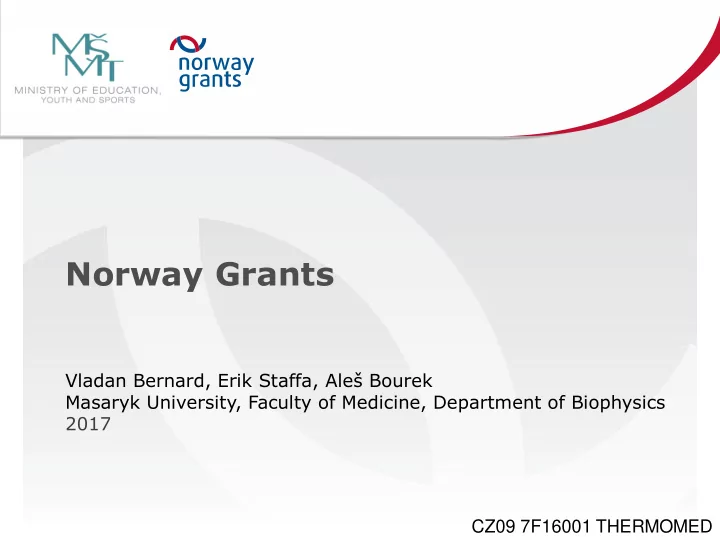

Norway Grants Vladan Bernard, Erik Staffa, Aleš Bourek Masaryk University, Faculty of Medicine, Department of Biophysics 2017 CZ09 7F16001 THERMOMED
Norway Grants Establishment of bilateral cooperation and exchange of experience in the field of medical infrared thermography CZ09 7F16001 THERMOMED
Radiofrequency tissue ablation- thermographic study Study realized 2013-2016 Faculty of Medicine MU + Faculty Hospital Brno Consist of ex vivo experiments and clinical study Original article in IRBM, 2014 CZ09 7F16001 THERMOMED
Radiofrequency tissue ablation- thermographic study Objectives and questions: Describe the process of RFA within the temperature distribution dynamic of heating process monopolar and bipolar heating Focusing specifically on: position of stent and indifferent plate electrode effect of conductive contact of electrode and stent CZ09 7F16001 THERMOMED
Radiofrequency tissue ablation- thermographic study Why stents? • Biliary stents are mostly used to threat obstruction that occur in the bile ducts (cancer). • Stents are blocked in a few months after their implanting. • The inner space of stent make passable by RFA. • How to use RFA in this case? • What happen in case of the conductive contact stent-active electrode? CZ09 7F16001 THERMOMED
Radiofrequency tissue ablation- thermographic study The experimental design: ex vivo experiment • EGIS Biliary stents 10 mm x 80 mm • Catether EndoHPB 8F 180 cm (monopole and bipole heating) • RF generator Rita 1500X RF, 460 kHz • Infrared thermal camera Flir B200, Flir i7 CZ09 7F16001 THERMOMED
Radiofrequency tissue ablation- thermographic study Time 2 min, power 60 W bipolar monopolar The difference in size and shape of the affected area of tissue CZ09 7F16001 THERMOMED
Radiofrequency tissue ablation- thermographic study Monopolar mode Temperature rises as a function of time and output power CZ09 7F16001 THERMOMED
Radiofrequency tissue ablation- thermographic study Time 4 min, power 60 W Maximum temperature was observed in the terminal parts of the stent CZ09 7F16001 THERMOMED
Radiofrequency tissue ablation- thermographic study Dynamic of heating of terminal parts of stent - in the case of asymmetrical position of stent towards to the plate electrode Plate electrode near part stent distant part Temperature increase as a function of position of stent CZ09 7F16001 THERMOMED
Radiofrequency tissue ablation- thermographic study Observation of a stent with symmetrical and asymmetrical position towards to the plate electrode visible difference in the temperatures of terminal parts of the stent, depending on the position of indifferent plate electrode CZ09 7F16001 THERMOMED
Radiofrequency tissue ablation- thermographic study Thermogram of a stent with asymmetrical position towards to the plate electrode Plate surface electrode CZ09 7F16001 THERMOMED
Radiofrequency tissue ablation- thermographic study Results The influence of output power and time duration of the RF on final temperature (of tissue or stent) The effect of increasing of temperature of the stent in the case of conductive connection of stent with the active electrode Increasing of temperature in the terminal parts of the stent compared to the middle part of stents The influence of the position of the indifferent plate electrode - symmetry, asymmetry- on the heating process Presented experiments have shown the possibility of using infrared thermal imaging camera for monitoring and visualization of the RF CZ09 7F16001 THERMOMED
A thermographic comparison of Irreversible Electroporation and RFA Study realized 2016-(2018) Faculty of Medicine MU + Faculty Hospital Brno + Brno University of Technology Consist of ex vivo experiments and in vivo animal model study Testing of high-energy current generator of team ´ s own design Original article in IRBM, 2017 CZ09 7F16001 THERMOMED
A thermographic comparison of Irreversible Electroporation and RFA IRE – new method used in ablation of parenchymal organs Non-thermal effect Application of very short pulses of electric current under high voltage Induced instability of polarized lipid bilayers with effect of creating pores in cell membranes The connective and fibrous tissues are not destroyed (vascular structure, biliary tract, …) Application in tumor treatment CZ09 7F16001 THERMOMED
A thermographic comparison of Irreversible Electroporation and RFA Ex vivo experiments on liver tissue Generator of own construction 50 pulses of 100 µs, output voltage 1500 -2500 V, current 4-10 A New designed balloon catheter with 3 electr. Flir B200 CZ09 7F16001 THERMOMED
A thermographic comparison of Irreversible Electroporation and RFA IRE, 150 pulses of 100 µs each 0.6 W (1500 V) 2.5 W (2500 V) CZ09 7F16001 THERMOMED
A thermographic comparison of Irreversible Electroporation and RFA Temperature profile of tissue in position of IRE and RFA application CZ09 7F16001 THERMOMED
A thermographic comparison of Irreversible Electroporation and RFA Results Verification of functions of the IRE device Characterization of heat process of IRE Comparing of IRE and FRA thermal effect in the same or similarly case of application CZ09 7F16001 THERMOMED
THERMOMED 2017 Thank you for your attention Acknowledgment: The research leading to these results has received funding from the Norwegian Financial Mechanism 2009-2017 and the Czech Ministry of Education, Youth and Sports under Project Contract no. MSMT- CZ09 7F16001 CZ09 7F16001 THERMOMED
Recommend
More recommend